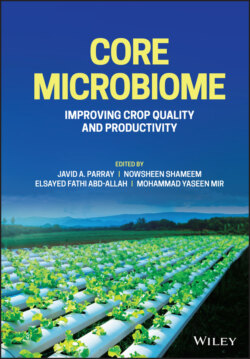Читать книгу Core Microbiome - Группа авторов - Страница 11
1.4 Plant Growth-Promoting Rhizobacteria (PGPR): Biological Management of Plant Pathogens
ОглавлениеIn plant pathology, “biocontrol” is often considered weapon to manage plant diseases. It is the use of antimicrobial compounds produced by microbial antagonists. Microorganisms that control the causative agents of plant diseases are collectively known as “biological control agents” (BCA) [36] with microorganisms, chemical mediators, and natural substances [37]. Endophytes are the microbial antagonists, mainly fungal and bacterial, that play an essential role in controlling disease. Both of them act differently to effect biological control, from the struggle at the niche level (colonization) during the making of antimicrobial compounds to bringing on the host resistance response [38–42], thus aiding in enhancing plant development along with health.
The constricted zone of soil particularly inclined by the root system is the rhizosphere [43]. This zone is loaded with nutrients due to the abundance of plant secretions, like amino acids and sugars, compared with most of the earth, providing a good source of energy and nutrients for bacteria [44]. Various microorganisms colonize the rhizosphere, and therefore, the bacteria settling in this environment are called rhizobacteria [45]. Plant-linked bacteria are often categorized within three groups, i.e. beneficial, harmful, and neutral groups, based on their effects on plant growth [43]. Beneficial free-living soil bacteria are usually characterized as PGPR [46]. Bacteria of various genera are identified as PGPR, of which the most important groups are Bacillus and Pseudomonas spp. [47]. PGPR affects plant growth directly or indirectly. The direct promotion of plant growth by PGPR involves providing the plant with a compound synthesized by the bacterium, for example, plant hormones, or promoting the uptake of certain nutrients from the environment [48]. The indirect progress of plant growth happens when PGPR prevents or reduces the harmful effects of one or more phytopathogenic organisms. This can be done by inducing resistance to pathogens or producing antagonistic substances [49].
